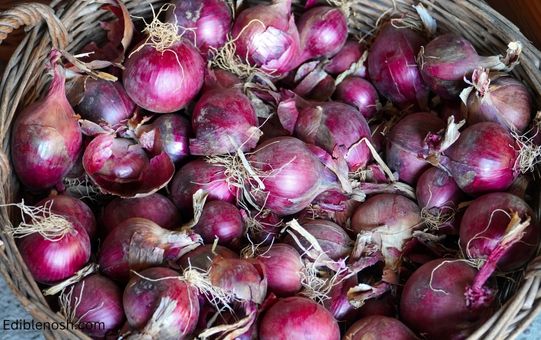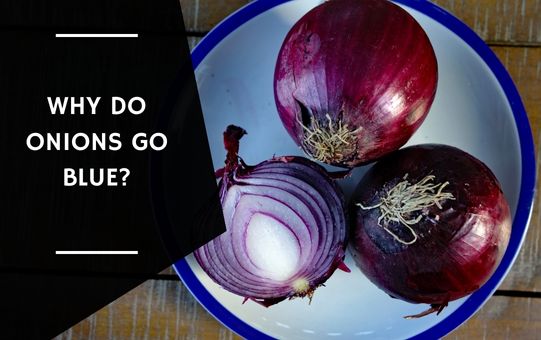Why do Onions go blue when they are an excellent source of vitamins and minerals, making them one of the world’s healthiest foods? More onions are enriched with vitamin C and potassium. But why do they get blue to let’s uncover the answer?
Due to pH levels, natural color change, incorrect storage, and cooking, onions can turn blue. The color change is typically reversible and has no impact on the onion’s flavor or safety.
Read the subsequent article to learn more about why onions turn blue.
Contents
Why Do Onions Go Blue matter?
The color of onion may not seem like a big deal, but it can actually affect the appearance and potentially the taste of a dish. Onion blue colour might not look as appetizing as a white or yellow one, and it could potentially change the overall color of the dish.
For example, if you’re making a salad with sliced onions and the onions turn blue, the salad may not look as appealing.
In addition, the Onion blue colour can also indicate its quality and freshness. If an onion has turned blue due to improper storage or the growth of bacteria or fungi, it might not be as fresh as an onion that is a more typical color. This could affect the taste and texture of the onion, and it could potentially be harmful if the onion has gone bad.
Read Also: Why Do Onions Last So Long?
The science behind onions turning blue
Onions contain a pigment called anthocyanin, which is pH-sensitive and will change color based on the acidity or basicity of its surroundings.
Onions also contain a variety of natural pigments that can react with each other to produce blue or purple hues.

In addition, improper storage and cooking can also cause onions to turn blue due to the growth of bacteria or fungi and the Maillard reaction, respectively.
Reasons why onion goes Blue
Here are the following reasons why onion goes blue:
Acids and Bases
One reason why onions might turn blue is due to the pH levels of the surrounding environment. Onions contain a pigment called anthocyanin, which is pH-sensitive. This means that it will change color based on the acidity or basicity of its surroundings.
When onions are sliced or chopped, their cells are disrupted, releasing enzymes that can convert certain amino acids into pigments. If the onion is in an acidic environment, the pigments will turn red or pink. If the onion is in a basic environment, the pigments will turn blue or purple.
This process is reversible, so if the onion is placed in a different environment with a different pH level, the color will change again. For example, if a sliced onion is placed in a bowl of vinegar, it will turn pink or red. But if the same onion is placed in a bowl of baking soda, it will turn blue or purple.
Natural Variation
Another reason why onions might turn blue is due to natural variation in the pigments produced by the onion itself. Different onion varieties contain different amounts and types of pigments, and these pigments can sometimes react with each other to produce blue or purple hues.
For example, some varieties of red onions contain a pigment called lycopene, which can turn blue or purple when it reacts with other pigments in the onion. Similarly, some varieties of white onions contain a pigment called flavonol, which can also turn blue or purple when it reacts with other pigments.
Storage Conditions
The storage conditions of onions can also affect their color. Onions should be stored in a cool, dry place to prevent them from rotting or sprouting. If they are stored in humid or damp conditions, they may develop blue or purple hues due to the growth of certain types of bacteria or fungi.

Cooking
Finally, Onion blue colour or purple colour when they are cooked is due to the Maillard reaction, which is a chemical reaction that occurs between amino acids and sugars when food is heated. This reaction can produce a range of colors, including blue and purple, depending on the specific amino acids and sugars present in the food.
Onions contain a number of amino acids and sugars that can react with each other during cooking, so it’s not uncommon for onions to turn blue or purple when they are sautéed, grilled, or baked. This is especially true if the onions are caramelized, as the high heat and extended cooking time can intensify the Maillard reaction.
How to prevent onions from turning blue?
To prevent onions from turning blue, you can try the following:
- Store onions in a cool, dry place to prevent the growth of bacteria or fungi.
- Avoid exposing onions to acidic or basic environments. If you do need to slice or chop onions in advance, store them in a neutral environment with a neutral pH.
- Choose onion varieties that are less prone to turning blue. Some varieties, such as white or yellow onions, contain fewer pigments that can react with each other to produce blue or purple hues.
- Cook onions at a lower heat or for a shorter amount of time to reduce the chances of the Maillard reaction occurring.
Keep in mind that it’s not always possible to prevent onions from turning blue, as some of the factors that contribute to this color change are out of our control. However, following these tips can help minimize the chances of it happening.
Read Also: Why Do You Rub an Onion on the Grill?
why do red onions turn blue?
Red onions contain a pigment called anthocyanin, which gives them their characteristic reddish-purple color. However, when red onions are cooked or sliced, the anthocyanin pigments can react with certain substances in their environment, such as acids or bases, and change color.
In particular, when red onions are exposed to acidic substances like vinegar or lemon juice, the anthocyanin pigments can turn a blue or greenish color. This happens because the acids cause the anthocyanins to lose their hydrogen ions, which changes their chemical structure and alters their color.
This color change is known as a “pH indicator reaction” and is often used in chemistry to detect the acidity or basicity of a solution. In the case of red onions, the blue color is not harmful and can actually be quite striking, but it is a temporary effect that will fade over time as the onions are exposed to air and light.
Why onions turn blue after cooking?
Onions turned blue or blue-green when they are cooked, and this is often a result of a chemical reaction between the onion’s natural pigments and other compounds in the food or cooking process.
One possible explanation about onions turn blue while cooking is that when onions are heated, their natural pigments called anthocyanins can react with acids present in the food or cooking process, which causes the pigment to turn blue or blue-green. This is because the heat causes the anthocyanins to break down and release hydrogen ions, which then interact with other compounds to produce the blue color.
Another possible explanation is that onions can contain sulfur compounds, such as sulfides or thiosulfinates, that can react with metal ions in cooking utensils or water to produce a blue or blue-green color. This can be particularly noticeable when cooking onions in copper or iron pots or using hard water that contains high levels of iron.
Final Thought
The mysterious blue hue of onions can be caused by a variety of factors, including pH levels, natural pigment variation, storage conditions, and cooking. While it may be alarming to see an onion turn blue, it is usually a harmless and reversible occurrence that does not affect the onion’s taste or safety.
By understanding the science behind why onions turn blue and taking steps to prevent it, you can ensure that your onions maintain their desired color and quality.
So the next time you notice a blue onion, don’t be surprised – just embrace the weird and wonderful world of onion chemistry!
FAQs | Onions Go Blue
Here are a few FAQs related to why onion go blue:
Why Do Onions Turn Blue?
Onions can turn blue due to pH levels, natural pigment variation, improper storage, and cooking. The color change is often reversible and does not affect the onion’s taste or safety.
is it safe to eat onions that have turned blue?
As long as the onion smells and tastes normal, it should be safe to eat. The blue color is usually a harmless and reversible occurrence that does not affect the onion’s quality or taste.
How Can I Prevent Onions From Turning Blue?
To prevent onions from turning blue, store them in a cool, dry place, avoid exposing them to acidic or basic environments, choose onion varieties that are less prone to turning blue, and cook them at a lower heat or for a shorter amount of time.
Can I Still Use A Blue Onion In Cooking?
Yes, you can still use a blue onion in cooking. The blue color will likely disappear once the onion is cooked, and it will not affect the taste or safety of the dish.
Are Blue Onions More Flavorful Or Nutritious Than Other Onion Varieties?
The color of an onion does not affect its flavor or nutritional content. Some onion varieties may have slightly different flavors or textures, but they are all generally nutritious and can be used in a variety of dishes.

